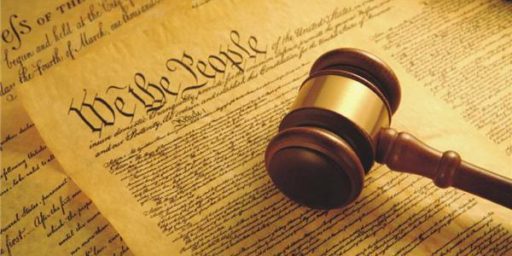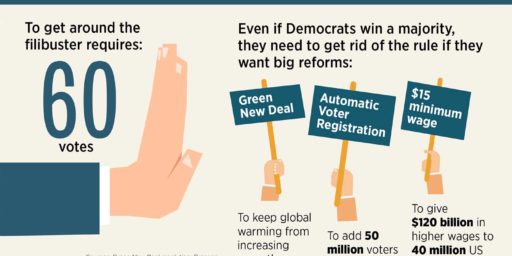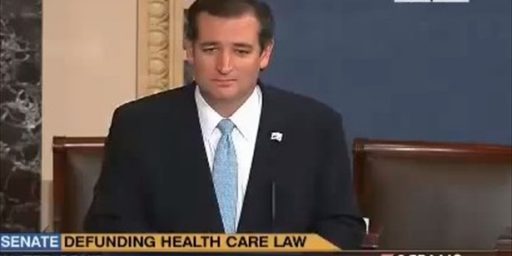End Abuse of Filibuster
Former Senate Majority Leader Bob Dole and C. Boyden Gray, former legal advisor to President George H.W. Bush, offer compelling arguments in separate op-eds this morning on why the practice of filibustering judicial nominees must end.
Dole’s piece is entitled, “Up, Down or Out” (NYT | RSS)
By creating a new threshold for the confirmation of judicial nominees, the Democratic minority has abandoned the tradition of mutual self-restraint that has long allowed the Senate to function as an institution. This tradition has a bipartisan pedigree.
[…]
When I was a leader in the Senate, a judicial filibuster was not part of my procedural playbook. Asking a senator to filibuster a judicial nomination was considered an abrogation of some 200 years of Senate tradition.
To be fair, the Democrats have previously refrained from resorting to the filibuster even when confronted with controversial judicial nominees like Robert Bork and Clarence Thomas. Although these men were treated poorly, they were at least given the courtesy of an up-or-down vote on the Senate floor. At the time, filibustering their nominations was not considered a legitimate option by my Democratic colleagues – if it had been, Justice Thomas might not be on the Supreme Court today, since his nomination was approved with only 52 votes, eight short of the 60 votes needed to close debate.
That’s why the current obstruction effort of the Democratic leadership is so extraordinary. President Bush has the lowest appellate-court confirmation rate of any modern president. Each of the 10 filibuster victims has been rated “qualified” or “well qualified” by the American Bar Association. Each has the support of a majority in the Senate. And each would now be serving on the federal bench if his or her nomination were subject to the traditional majority-vote standard.
This 60-vote standard for judicial nominees has the effect of arrogating power from the president to the Senate. Future presidents must now ask themselves whether their judicial nominees can secure the supermajority needed to break a potential filibuster. Political considerations will now become even more central to the judicial selection process. Is this what the framers intended?
Gray’s piece, “End abuse of filibuster” (USA Today) is even more persuasive:
We often hear of the Senate’s history as the “cooling saucer.” Yet this analogy doesn’t refer to the filibuster, or even limitless Senate debate, which was not used as a blocking mechanism in the republic’s early years. Rather, the Senate was “cooler” than the House of Representatives because its members were elected to six-year terms – separated by election into three classes – and, primarily, because its members were chosen not by the people but by the state legislatures. Thus, senators were thought to be aloof from the short-term passions and pressures of the House.
[…]
The filibuster is not enshrined among the Constitution’s system of checks and balances. Judicial filibusters of majority-supported nominees have never been part of the Senate’s tradition. In the past two decades, even with the stakes at their highest, Democrats did not filibuster Supreme Court nominees Robert Bork or Clarence Thomas. Yet in the 108th Congress, Democrats filibustered 10 of 34 appellate court nominees. President Bush’s first-term appellate confirmation rate was the lowest in modern times.
The filibuster is not sacrosanct. In fact, there are dozens of laws on the books today that prohibit filibusters on a variety of measures. If it is acceptable, for example, for fast-track authority to preclude filibuster of trade agreements, surely it is acceptable to preclude filibusters where they have never been used in 200 years.
Quite right. Unfortunately, the public has been ill-served by incompetent civics teachers, who misinform students about the nature of checks and balances. The nonsense about the Framers creating three “co-equal” branches and the inclusion of the filibuster as part of the checks and balances mechanism is so ingrained in most people that the actual history of the Constitution seems odd.
Update (1109): Steven Taylor has a much more extensive discussion of the theory behind checks and balances, the origins of the filibuster, and the way Congress works.
Update (1214): Welcome Hotline readers. Take a look around.






I really haven’t seen anyone talk about the fillibuster as a check/balance per se. Rather, the most common argument has been that it’s an internal check/balance to partisan politics which is perfectly consistent with the Senate’s role as the “cooler” of politics. This conception doesn’t claim that the filly is a constitutional C/B mechanism, but proceeds from an originalist conception of wht the senate was supposed to be.
jpe: I’ve certainly seen a lot of talk from the C/B perspective. Morever, there’s nothing originalist about the filibuster.
The Senate was supposed to be the “cooler” because of the institutional setup, not obstructionism. Vice the House, the Senate is likely to be more reflective because:
-6 year terms vice 2 enables a longer view
-statewide vice district election tends toward moderation, bigger picture view
-smaller size (now 100 vice 435) emphasizes collegiality
A question for any conservative. How would you spin the elimination of the filibuster in such a manner so that you all can support it again in a few years without appearing too hypocritical? Conservatives used to be pro filibuster, used it quite often in the ’90’s, and certainly will be staunch supporters of the filibuster again as soon as the Dems retake congress.